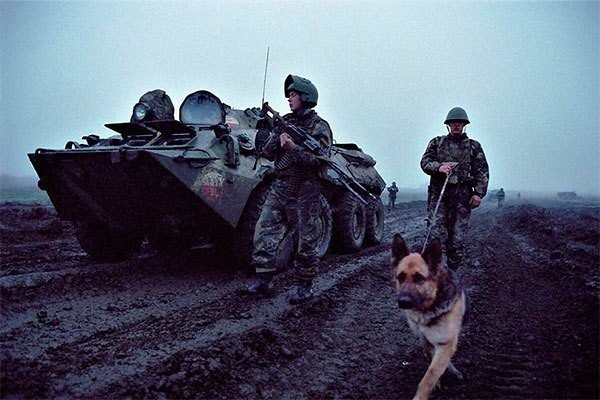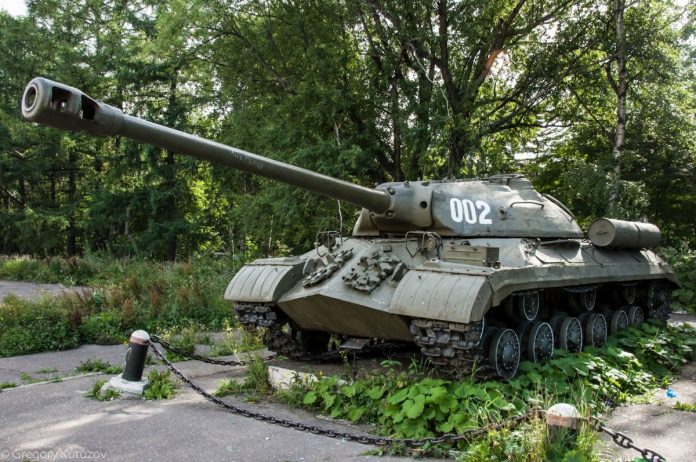
IS-3 was the last Soviet heavy tanks, designed and launched into mass production during the war. The development in 1944 year, he did not appear on the battlefields of Europe, but he had the honor to pass triumphant march of the defeated Berlin, participating in the largest military parade the Allies in September 1945 of the year.
History of creation
On the eve of the Great Patriotic War, the production of heavy tanks in the Soviet Union was engaged in the Leningrad Kirov factory (LCO). Right here, SDB-2, under the leadership of the plant ZH.YA. Kotin was designed by the famous heavy KV-1 with a powerful booking protivosnaryadnym.
To 22 June 1941 year LB managed to build 636 KV tanks. but in the fall 1941 year due to continue the offensive of the German troops in the north-west direction of the threat and the capture of Leningrad was decided to LB evacuation Chelyabinsk to Chelyabinsk Tractor Plant. IV. Stalin (ÇTZ), with LB here is evacuated and part of the Tank Design Bureau of SKB-2. So in October 1941 the Chelyabinsk Kirov Plant is the result of combining LB and CTZ (ÇKZ), which later became known informally as "Tankograd".
CHKZ director was appointed IM. Zalitsman (former director of LB), he is from June 1942 to July 1943 I was acting People's Commissar for Tank Industry. Chief designer of the plant became ZH.YA. Kotin.
The need for continuous improvement and upgrade of military equipment required to establish a special research base. Therefore, at the end of 1943 by the order of People's Commissariat of the Tank Industry from the CHKZ was isolated Pilot Plant №100. Its director was NN. Voroshilov, chief designer - AS. Ermolaev.
Director CHKZ remained IM. Zalitsman, a poredevšee KB "Tankograd" vozglavil N. L.. spirits. Although the main objective was CB tank structure refinement, already standing on the conveyor, rationalization and technology, Nevertheless CHKZ designers in parallel with this developed several of its own projects of new tanks. Not surprising, between teams of designers, worked on CHKZ and Pilot Plant №100, who worked officially under the general direction ZH.YA. litter, It flared up pretty stiff competition.
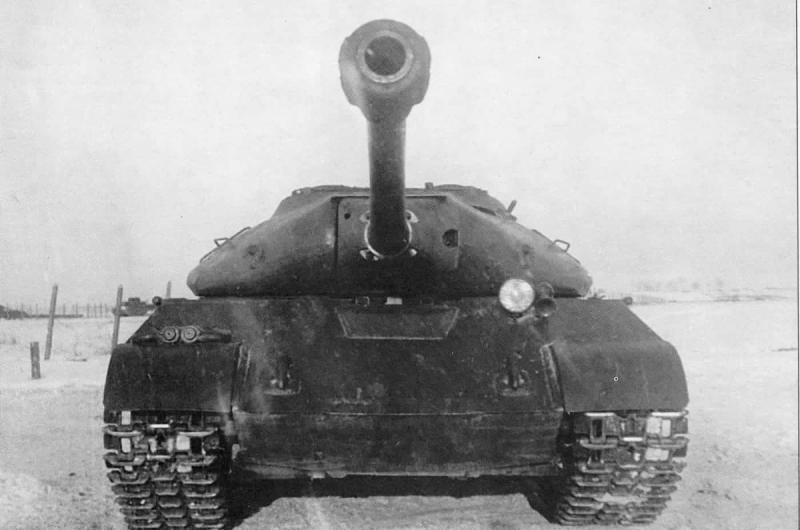 Experimental tank "Kirovets-1", 1944 g.
Experimental tank "Kirovets-1", 1944 g.
In July 1943 CHKZ year, work began on the creation of the project of a new heavy tank. It has been tasked to develop a promising designers heavy tank for the final phase of the war and the postwar period. Initially, the work on the tank (at this stage called "the tanks to") were conducted with some secrecy, of them were not informed nor the People's Commissar for Tank Industry VA. Malyshev, or the first secretary of the Chelyabinsk Regional Party Committee NS. Patolichev, and they were funded directly from the factory budget. Only in March 1944 , the technical design of the new tank, received factory designation "object 701", It was sent to the Main Armored Directorate of the Red Army (GBTU CA). Overall, the project was approved, and already legally, in accordance with the resolution of GKO №5583, on CHKZ we started manufacturing two prototypes of the "object 701".
AT 1944 year, new research conducted at the pilot plant and the number 100. It worked just over three samples of heavy tanks, had code names IS-3, IS-4 and CI-6. Because, according to the military, tank IS-2 I had too little ammunition to the gun (Total 28 shots), in new cars the designers have tried to provide the same amazing properties projectile tank gun, which had a 122 mm cannon IC 2, but on a smaller caliber, respectively increased and Ammo.
Besides, after studying the battle damage, obtained by tanks during the Battle of Kursk, when Soviet tank armies broke through the defensive line of well-trained Germans, saturated antitank weapons, it was found, that not all of the turret and hull tanks amazed with equal probability. In droves marveled at it head-on elements, with the number of hits in the tower was the largest. Based on these results, GBTU require significantly enhanced armor protection of the JS-2 tanks.
The CRI-48 have been developed recommendations based on military requirements on the one hand and technological possibilities of the other plants. But if the proposed option strengthening armor bow of the hull can be realized relatively simply (thick upper part 90 mm armor rolled with slope 600 ), the tower of the JS-2 radically enhance body armor without a sharp increase in its weight does not budge (and so it was originally designed for the installation and equilibrated with 85 mm cannons, and it has stood much more difficult - 122 mm), so it is recommended to re-design. 15 Martha 1944 year NKTP order №158 was released, whereby CHKZ ordered, using CRI-48 recommendations, develop and issue to production drawings enhanced reservation for IC tank.
8 April 1944 It issued a decree of the Civil Code №5583 «On production of a prototype of a new heavy tank at the Kirov plant". can say, from that moment and began work on a tank, who later became known as the IS-3. In this way, in fact IS-3 was the result of deep modernization of the IS-2, undertaken with a view to strengthening its armored protection.
CHKZ on designing a new tank was carried out by designers under the leadership of NL. Pentecost, directly supervised project MF. BAL. The main activities, that at the initial stage of the work is going to implement the designers, were the: replacement of cast structure of the nose to the tank welded from rolled sheets, which would provide neprobivaemost its projectiles German tank "Panther" and "Tiger", Modification and increase the thickness of armor front of the tower (is has the strength equal to the front part of the housing), boeukladki change.
Need to say, at that moment on CHKZ a critical situation with the production of the IS-2 tanks (the number of defect-free vehicles was only 3%). In order for №235 from NKTP 15 April 1944 year even indicated, that if the quality of the products on CHKZ not improve, Officials of the Kirov plant will be brought to the harsh responsibility. Besides, as mentioned above, at the Chelyabinsk Kirov plant in July 1943 , work began to create its own new heavy tank ("Object 701"), Technical draft of which was presented in the Main Armored Directorate of the Red Army in March 1944 of the year.
clear, that in such a situation, the work on the project of a new tank with enhanced reservation went very slowly and deadlines, defined in the joint order NKTP and HBTU, They were foiled (it was necessary to put the two prototypes to 25 June 1944 of the year). All plant management attention was focused on the construction of a prototype of his car - "Object 701". Just making sure, that quickly bring up to standard design your machine will not be able, the efforts of designers were diverted to work on the modernization of IP-2. Naturally, that in this process they used and proven technical solutions, found during the development of the "object 701".
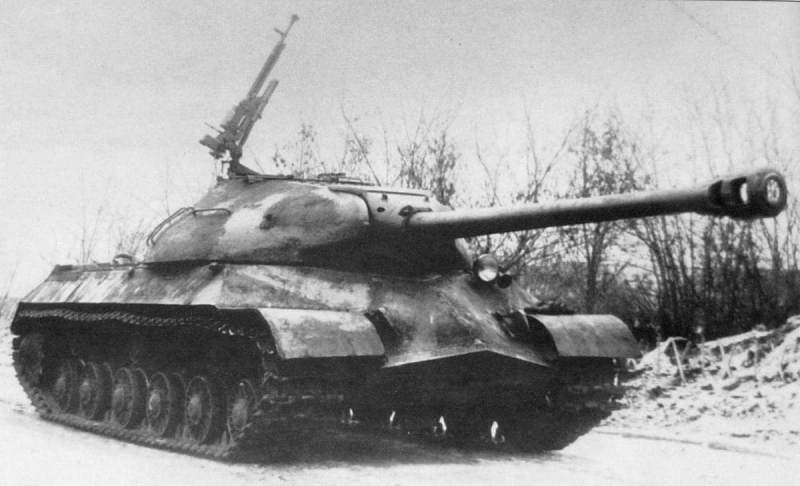 IS-3 on tests, March 1945 g.
IS-3 on tests, March 1945 g.
As a result of the improved IP drawings have been directed to the HBTU in only the second half of August. After receiving a positive opinion on CHKZ began building prototype. To assemble the body of the modernized tank started 2 September, but work on it has been very slow. Only 28 October he was able to show the military acceptance, and late in the evening 31 October tank left the assembly shop and Broad Kalmaktskomu path went to the factory landfill, Located outside the city. There he made the first test run, which the, true, I ended unsuccessfully (I discovered an oil leak from a check point). In November, after repairs have been carried out factory 1000 kilometer sea trials, that 18 November because of the accident had to be interrupted.
tests have shown, that the problems are mainly related to the, CHKZ that designers have modernized in IC design is very significant changes, and time for their thorough refinement and testing, as always, not hvatilo. So, eg, on an experimental machine was installed a more powerful engine B-11 (620 hp), as a result of transmission (remaining old) I worked with congestion and failure of.
On the other hand, military were quite satisfied with the mobility of the IS-2 tank with the engine in the power-2IS 520 HP. Considering, that the bulk of the planned changes did not lead to a substantial increase in combat capabilities of IP-2, but complicate the production and caused problems in the course of its operation, CHKZ designers abandoned the changes in chassis design, powerplant and transmission of IP-2 tanks and confined only to the task of improving its armor protection (what actually, and demanded a resolution GC №5583).
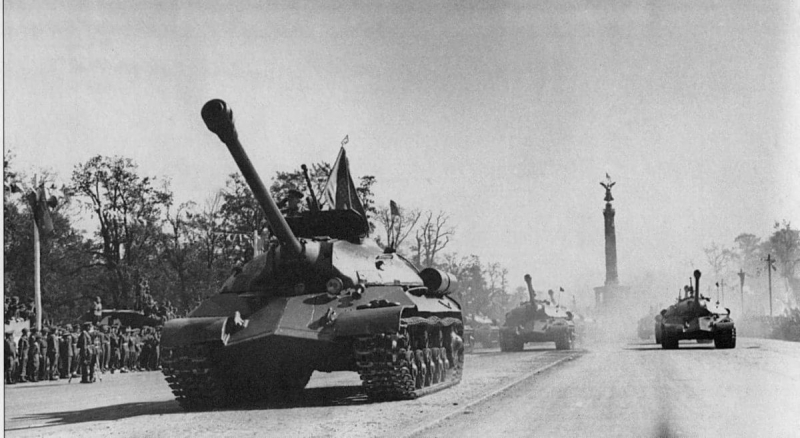 Parade allies in Berlin, September 1945 of the year. Tanks IS-3 from the 71 th Guards regiment of heavy tanks are on the highway Charlottenburg
Parade allies in Berlin, September 1945 of the year. Tanks IS-3 from the 71 th Guards regiment of heavy tanks are on the highway Charlottenburg
In accordance with the data, obtained from CRI-48, CHKZ designers chose angles and differentiated thickness armor. Particular attention was paid to the armor protection tower, whose defeat was considered the most likely. Other changes have been directed at improving the performance of.
The second prototype of the upgraded IS-2 was commissioned plant in Chelyabinsk 25 November 1944 of the year. In the documents of the military office, he was designated as "Sample A", and the institutions - "Kirovec-1". 24 November, he was tested factory mileage (30 km), and the next day without significant comment was voenpredovsky run (50 km) and he was admitted to the further tests. In the course of their, Commander of the Order of BT and MV SC, the car has received the name - "heavy tank IS-3 (sample №1)».
Compared with the IS-2 tank of the new machine has the following differences. Her body is completely welded from rolled armor plates and had cast armor parts, wherein the trough-shape bottom had, and board components were (welded together from upper and lower vertical parts). Adjusting the thickness and angle of inclination of body armor plates made him virtually invulnerable to any caliber tank and anti-tank artillery enemy.
The main feature of the project was flattened tower, developed by designer GV. Kruchenykh. Large angles of inclination of its walls contribute to the enemy's shells ricochet, and rational internal arrangement enabled without excessively increasing weight (compared with the IS-2 tower) significantly increase the thickness of its reservation. New tower shape is a spherical segment and cast single piece. Thickness of boards reservation in its front portion (near the gun mantlet) reached 360 mm, and in other directions is not less than 160 mm, roof - 30 mm. tank armament remained the same - 122 mm tank gun D-25. small changes were made to the design of the tank to increase transmission reliability of its operation.
16 December tank was officially handed over to the state tests, which were conducted on a NIIBTpoligone 18 by 24 December. According to test results 30 December was compiled report, in which noted, the shelling of the new tank corps showed it significantly better armor protection compared to the IS-2 housing, and in terms of reliability and performance similar to a tank IS-2. The conclusions stated, that after the elimination of the shortcomings identified in the report of the modernized tank sample is recommended for adopting.
During tests at the site shows new tank was the deputy commander of the armored and mechanized forces of the Red Army Marshal of Armored Forces PA. Rotmistrov. He inspected the car from all sides, I climbed into the tank, I sat on a place of the driver and, after hearing a detailed report to the leading engineer MF. BAL, He said: "This is such a machine is needed army!».
Upon learning, CHKZ that designed and built the new tank, ZH.YA. Kotin immediately prepared its own version, based on the development of the Pilot Plant facilities 244, 245 and 248. In December, Pilot Plant №100 and CRI-48 submitted to the Commissariat of the Tank Industry a project of modernization of armored protection IS-2.
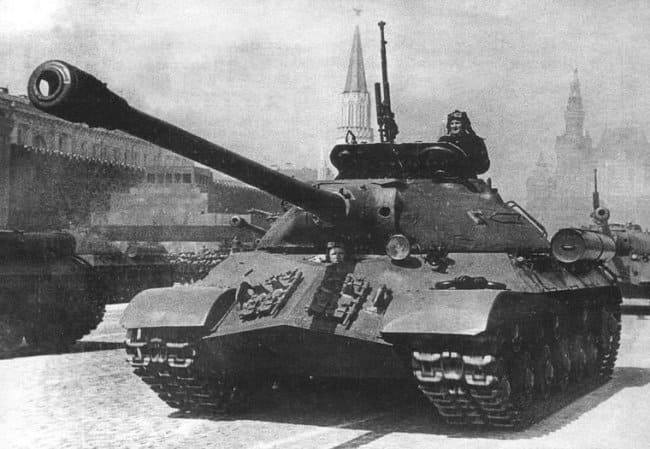 IS-3 at the parade in Moscow, 1946 year
IS-3 at the parade in Moscow, 1946 year
can say, that the "highlight" of the project was the original form of the radome. Virtually all the tanks of the period upper frontal part of the housing is a relatively flat surface, perpendicular to the longitudinal axis of the tank and inclined to the vertical,. Such a shape dictated by the, that housed two crew members in the front of the case, and in some cases, transmission (the layout of the engine in the rear of the tank and in front of transmission). but, when the crew was excluded gunner and also a driver sitting in the middle, It appears able to "bend" the frontal plate. So, already in the IS-2 on the cast front part appeared "cheekbone".
Designers Expert GN plant. Moskvin and VI. Tarotko went further, suggesting make the entire upper frontal part of the housing of the two welded and strongly inclined in the vertical plane armor plates. Above these sheets were covered with a triangular roof, inclined to the horizon at an angle 7 degrees. In her driver's hatch was organized, through which he could sit down and leave the tank, which greatly facilitates the conditions of its operation compared with the tank IS-2, in which the mechanics had to get into the tank through the hatches of the tower. Such gable nose first got in the Constructors' Title "aquiline nose", but more widespread received another name - "pike nose".
Need to say, that in the draft CHKZ, and the project of the Experimental housing design of the plant has been fully welded, without large cast parts. This had several reasons. One side, at that time it was well mastered by automatic welding armor, on the other hand - foundry was fully downloaded manufacture of cast towers for IS-2. Moreover in USSR strength cast parts inferior weld (eg, in USA, where the quality of cast steel was higher, tanks more widely used namely castings).
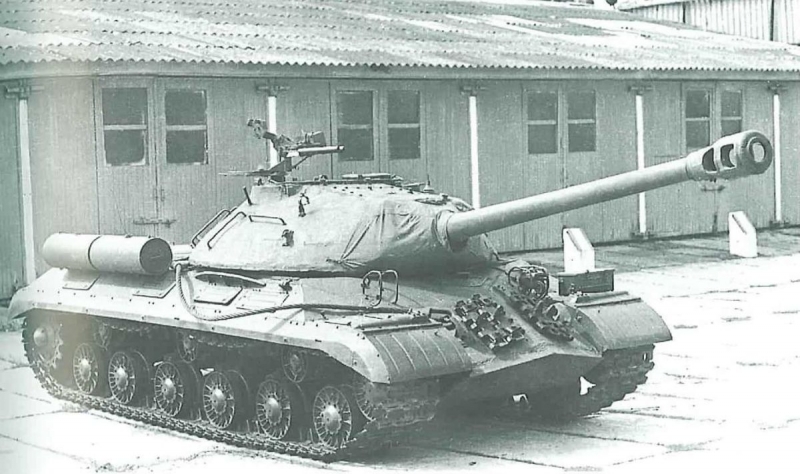 IS-3M in the park one of the tank units
IS-3M in the park one of the tank units
Because, that NKTP Now there were two separate projects - two variants of a single tank, who presented the director of CHKZ IM. Salzman and chief designer of the NL. spirits, and from the Pilot Plant - Director and Chief Designer ZH.YA. Kotin, in their comparative analysis was carried out the Moscow branch of the CRI-48. The report CRI-48, compiled according to the results, It was observed, that each of the proposed designs has its advantages, and the optimal solution to the issue of improving body armor tank IS-2 will be the creation of such a structure, which maximize the benefits of both projects would be used. It was suggested, to construct a new armored protection ICs tank following elements have been incorporated:
- the nose portion of the housing must be made by the type, proposed pilot plant number 100 - Dual nose.
- bottom of the hull structure should be made of the Kirov factory - trough-shaped.
- tower structure must be designed so, to its cross-section has been used the principle, proposed by the Kirov factory: dome shape, and horizontal sections - the principle towers Pilot Plant number 100: cross section close to an ellipse.
The estimates and calculations showed, that when using the above-mentioned proposals had the opportunity to create in the redistribution of the weight of the tank, Kirovsky said plant and pilot plant №100, protection of armor, which would provide the probability of penetration of armor-piercing shell the German 88-mm projectile equal to all 34% (for construction CHKZ it was - 44,1%, and for the plant №100 - 39,5%).
Having considered both the project and the recommendations of CRI-48, People's Commissar for Tank Industry VA. Malyshev decided, according to which the new tank was supposed to be a kind of "hybrid". The project was taken CHKZ original spherical design of the tower with a high armor protection, trough-shaped bottom, helps reduce body weight, armor protection without reducing the bead. From Project Pilot Plant №100 was taken design sloping gable nose, which provides a high frontal armor protection of the hull and at the same time allowed which is located in her driver's hatch. Besides, from there was taken a constructive solution for tank fire control capabilities with the space vehicle commander. The project of the heavy tank on the basis of the IS-2 was commissioned to design the Kirov factory.
16 December 1944 year Order by NKTP №729 was released, which determined the course of further work on the creation of a new tank. He has been officially assigned code "Kirovets-1". The same order terms of work and the number of prototypes have been identified - ten pieces. Eight copies were to be fully assembled to 25 January 1945 of the year, the other two cars were not going to completely, it was just two blocks and two towers, which were intended to fire tests.
So there is a new model of the tank - the fruit of the labor of two tank builders design teams, divide that there is practically no possibility of. Here it should be noted and the, that prior to the formation of the Experimental Plant basic structure of its designers worked in the State in the territory of CHKZ and only later was gradually transferred to the Pilot Plant.
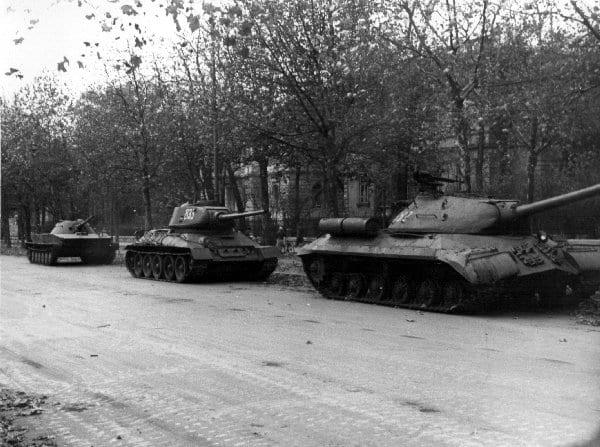 Soviet tanks, who participated in the Hungarian events 1956 of the year. Ahead of IS-3, followed by T-34/85, and in the background amphibious tank PT-76 early releases
Soviet tanks, who participated in the Hungarian events 1956 of the year. Ahead of IS-3, followed by T-34/85, and in the background amphibious tank PT-76 early releases
Since Stalin always followed closely the state of affairs in the tank industry, VA. Malyshev sent a letter to Supreme Commander, which provides justification for the development of a new heavy tank and describes its advantages over the IS-2. Acquainted with him, Stalin gave his consent to carry out works on a new car.
However, the timing, specified in the order №729, They were foiled. only to 12 February CHKZ managed to finish the assembly of the two hulls (№2 and №3), who were sent to NIIBTpoligon for their test fire. A first fully ready to IS-3 (№2) He was sent to Moscow 20 February, after he took military acceptance.
field testing, conducted in Kubinka, We passed as soon as possible, just two and a half weeks - with 23 March 11 April. After completion tank provided Marshal GK. Zhukov and Chief of General Staff Marshal AM. Vasilevskomu, which in turn report it to Stalin. Based on the conclusion of the commission, Stalin signed a decree GKO №7950 «About upgrading heavy tank IS-2". In that ruling, the performance characteristics of the serial IC-3 have been approved.
The second prototype IS-3 he entered the NIIBTpoligon test 16 Martha, which lasted until the middle of April. According to their results, the Commission produced a report and act, wherein the recommended IP-3 (a second sample) for serial production at the Chelyabinsk Kirov Plant, with deficiencies, mentioned in the Act. After the surrender of Germany, 21 May, Head GBTU TU KA AI. Blagonravov signed a decree "On approval of technical documentation on the IS-3 tank".
As of 24 May because 29 IS-3 tanks, It is still on the plant, only 17 factory tested. To end 1945 It had been issued 1711 IS-3 tanks, and parallel with continued production and IS-2 tanks. Serial production of IS-3 lasted until the middle of 1946 of the year, there have been built 2311 pcs.
AT 1945 by NL. Spirits of merit in the creation of heavy tank IS-3 was awarded the title of extraordinary inzhenergeneral Major, he was awarded the Order of Suvorov, and soon received, and the title of Hero of the Soviet Union with the award to him Gold Star and the Order of Lenin.
Laid down in the EC-3 structural solutions have had a huge impact on the further development of heavy tanks, primarily in the area of protection, the development of the ideology which used, adopted for the IP-3 - strong differentiation armor thickness in combination with rational geometry of the hull and turret. The same principle solutions were used in the construction of the last Soviet serial heavy tank IS-8, developed in the 1950 year (after Stalin's death, his name was changed to T-10), who was armed with Soviet, and then the Russian army to 1995 of the year.
The overall layout
so, what was the IS-3 design? At its creation location concept designers guided armor plates at large angles of inclination to the vertical, that the Soviet Union was first used in creating the T-34, and then actively used and the development of other Soviet tanks. Armor plating protected car (the thickness of which varied in wide limits), located at a large angle, which significantly increases the effective thickness of armor.
The design of the hull did not have analogues in the world tank manufacturing. Frontal sheet body were installed in the form of "pike nose" dual slope at large angles to the vertical. Upper part side was given a reverse slope, that was done, one side, to fit on the roof of the body is very wide turret, and on the other - to increase snaryadostoykosti boards. The bottom of the trough-shaped reduced the total body surface area, and due to the weight saved is to strengthen the armor protection elsewhere, Besides, thanks to such a shape increased its strength.
Cast tower IS-3 was quite perfect for the time form - flattened hemisphere, with a large wall thickness, it was very well inscribed gun mantlet. Through the use of this form of the tower IS-3 began on 280 mm below, What IS-2, which significantly reduced his visibility on the battlefield. To ensure high speed pointing guns at a target turret controls are duplicated on the ground gunner and tank commander.
Common disadvantages tank IS-3 may include greater complexity of manufacture (the cost of one car was 350 000 rubles), tightness in the fighting compartment - the internal volume of the machine was only 11,6 m3 , and a low rate of gun D-25T, who had separate loading.
Although the thickness of arms and the power IC-3 did not have armor while unmatched, tank dimensions do not exceed those of the IS-2.
To be continued…








